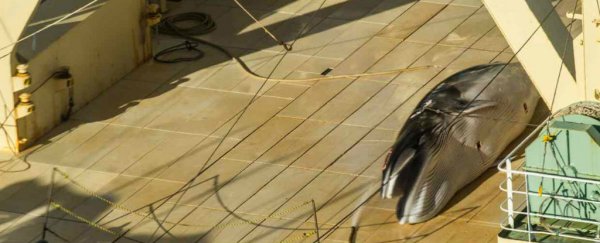A Japanese whaling ship has been caught with a dead minke whale on board while sailing through protected Australian waters, according to anti-whaling group, Sea Shepherd.
The group says it captured images of the whale carcass yesterday as their helicopter flew over the Japanese ship, Nisshin Maru, in Australia's Antarctic whale sanctuary. This is the first documented killing since the International Court of Justice deemed Japan's Antarctic whaling illegal back in 2014.
"The Nisshin Maru was spotted by the helicopter … at 12:34am GMT (11:34am AEDT) at a position of 64 57.6S - 085 09.6E, within the Australian Whale Sanctuary," Sea Shepherd reports.
Once the Sea Shepherd helicopter captured images of the minke whale, one of group's anti-whaling ships, the Steve Irwin, intercepted the Japanese whalers, and watched them try to hide the evidence.
According to the group, the whalers first covered the carcass with a tarpaulin, and then covered its harpoons so they could no longer be photographed.
 Glenn Lockitch/Sea Shepherd
Glenn Lockitch/Sea Shepherd
 Glenn Lockitch/Sea Shepherd
Glenn Lockitch/Sea Shepherd
"The whale killers from the Nisshin Maru were caught red-handed slaughtering whales in the Australian whale sanctuary," said Adam Meyerson, captain of the Sea Shepherd patrol ship Ocean Warrior.
"The Steve Irwin has shut down their illegal operations and caught them trying to hide the evidence."
As the most abundant species of baleen whale in the world, minke whales are found throughout the northern Atlantic and Pacific Oceans in the northern hemisphere, and off the coast of Australia, South America, and South Africa in the southern hemisphere, as well as in the Southern Ocean.
The species is classified as of "least concern" by the IUCN, but that doesn't mean whalers can just go hunting them at will.
In response to widespread hunting of several whale species, a moratorium on whaling began in 1986 to curb serious population decline, particularly among blue, fin, and humpback whales, but enforcing the terms of the moratorium has been anything but simple.
The International Whaling Commission has allowed 'objecting nations' to come up with their own annual quotas for whaling, so long as they're doing it for research purposes - something that has also been very difficult to regulate and enforce.
Since then, countries like Norway and Iceland have been taking advantage of these annual quotas, and Japan has given itself an annual quota of 333 minke whales a year.
As Daniel Flitton from The Sydney Morning Herald reports, Japan reportedly shipped home 333 dead minkes - including about 200 pregnant cows - over the past 12 months, under the guise of scientific research.
And they're courting even more controversy now, because even worse than their dubious claims of scientific research is getting caught secretly targeting minke whales in protected Australian waters.
"The fact that the Japanese crew went to cover up their harpoons and the dead minke whale on deck just shows that they know what they're doing is wrong," captain OF the Steve Irwin, Wyanda Lublink, said in a statement.
"They know they are in contempt of the ruling of the International Court of Justice and the Australian Federal Court."
And to make matters worse, there's nothing humane about how these whalers kill their whales.
"They're hit with an explosive harpoon that goes straight into their body, hooks come out, and shrapnel is sent through their body," Jeff Hansen from Sea Shepherd told ABC News.
"It's a terrible, bloody death… these whales can take up to 30 or 40 minutes to die."
The Sea Shepherd team has been shadowing the Japanese ship for five weeks now, and is committed to keeping tabs on them in the coming months.
The question remains if the Japanese whalers will be prosecuted, but it's up to the Australian government to pursue these allegations.
As The Guardian reports, Australia fined Japanese whalers AUD$1 million in 2015 over previous killings in Australian waters, but it's gone ignored and unpaid.
And there is some controversy over how legitimate Australia's claims are to these Antarctic waters - something that the Japanese government has in the past contested.
But Australian waters or not, there's no getting around the 2014 ban on Japanese whaling in the Antarctic.
Until officials in Australia, the International Whaling Commission, or the International Court of Justice figure out what they want to do about illegal whaling, it's a good thing we've got conservationists on the case, so at least this one death hasn't gone unnoticed.
